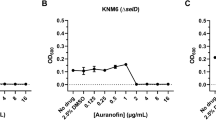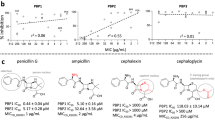Abstract
Clostridium difficile is a nosocomial pathogen whose incidence and importance are on the rise. Previous work in our laboratory characterized the central role of selenoenzyme-dependent Stickland reactions in C. difficile metabolism. In this work we have identified, using mass spectrometry, a stable complex formed upon reaction of auranofin (a gold-containing drug) with selenide in vitro. X-ray absorption spectroscopy supports the structure that we proposed on the basis of mass-spectrometric data. Auranofin potently inhibits the growth of C. difficile but does not similarly affect other clostridia that do not utilize selenoproteins to obtain energy. Moreover, auranofin inhibits the incorporation of radioisotope selenium (75Se) in selenoproteins in both Escherichia coli, the prokaryotic model for selenoprotein synthesis, and C. difficile without impacting total protein synthesis. Auranofin blocks the uptake of selenium and results in the accumulation of the auranofin–selenide adduct in the culture medium. Addition of selenium in the form of selenite or l-selenocysteine to the growth medium significantly reduces the inhibitory action of auranofin on the growth of C. difficile. On the basis of these results, we propose that formation of this complex and the subsequent deficiency in available selenium for selenoprotein synthesis is the mechanism by which auranofin inhibits C. difficile growth. This study demonstrates that targeting selenium metabolism provides a new avenue for antimicrobial development against C. difficile and other selenium-dependent pathogens.










Similar content being viewed by others
References
Kean WF, Hart L, Buchanan WW (1997) Br J Rheumatol 36:560–572
Messori L, Marcon G (2004) Met Ions Biol Syst 41:279–304
Becker K, Gromer S, Schirmer RH, Muller S (2000) Eur J Biochem 267:6118–6125
Gromer S, Arscott LD, Williams CH Jr, Schirmer RH, Becker K (1998) J Biol Chem 273:20096–20101
Lobanov AV, Gromer S, Salinas G, Gladyshev VN (2006) Nucleic Acids Res 34:4012–4024
Kuntz AN, Davioud-Charvet E, Sayed AA, Califf LL, Dessolin J, Arner ES, Williams DL (2007) PLoS Med 4:e206
Talbot S, Self WT (2008) Br J Pharmacol (in press)
Leinfelder W, Forchhammer K, Veprek B, Zehelein E, Bock A (1990) Proc Natl Acad Sci USA 87:543–547
Veres Z, Tsai L, Scholz TD, Politino M, Balaban RS, Stadtman TC (1992) Proc Natl Acad Sci USA 89:2975–2979
Veres Z, Kim IY, Scholz TD, Stadtman TC (1994) J Biol Chem 269:10597–10603
Ehrenreich A, Forchhammer K, Tormay P, Veprek B, Bock A (1992) Eur J Biochem 206:767–773
Glass RS, Singh WP, Jung W, Veres Z, Scholz TD, Stadtman TC (1993) Biochemistry 32:12555–12559
Forchhammer K, Leinfelder W, Boesmiller K, Veprek B, Bock A (1991) J Biol Chem 266:6318–6323
Forchhammer K, Bock A (1991) J Biol Chem 266:6324–6328
Forchhammer K, Leinfelder W, Bock A (1989) Nature 342:453–456
Papp LV, Lu J, Holmgren A, Khanna KK (2007) Antioxid Redox Signal 9:775–806
Jackson S, Calos M, Myers A, Self WT (2006) J Bacteriol 188:8487–8495
Rother M, Bock A, Wyss C (2001) Arch Microbiol 177:113–116
Lobanov AV, Delgado C, Rahlfs S, Novoselov SV, Kryukov GV, Gromer S, Hatfield DL, Becker K, Gladyshev VN (2006) Nucleic Acids Res 34:496–505
Kelly CP, LaMont JT (1998) Annu Rev Med 49:375–390
Kyne L, Hamel MB, Polavaram R, Kelly CP (2002) Clin Infect Dis 34:346–353
McDonald LC, Killgore GE, Thompson A, Owens RC Jr, Kazakova SV, Sambol SP, Johnson S, Gerding DN (2005) N Engl J Med 353:2433–2441
Redelings MD, Sorvillo F, Mascola L (2007) Emerg Infect Dis 13:1417–1419
Bourgault AM, Lamothe F, Loo VG, Poirier L (2006) Antimicrob Agents Chemother 50:3473–3475
Pepin J, Valiquette L, Gagnon S, Routhier S, Brazeau I (2007) Am J Gastroenterol 102:2781–2788
Gerding DN (2007) Infect Control Hosp Epidemiol 28:113–115
Klayman DL, Griffin TS (1973) J Am Chem Soc 91:197–199
Mahoney WC, Hermodson MA (1980) J Biol Chem 255:11199–11203
Apffel A, Fischer S, Goldberg G, Goodley PC, Kuhlmann FE (1995) J Chromatogr 712:177–190
Schneider D, Schuster O, Schmidbaur H (2005) Dalton Trans 1940–1947
Yang GA, Raptis RG (2003) Inorg Chim Acta 352:98–104
Freisinger E, Schimanski A, Lippert B (2001) J Biol Inorg Chem 6:378–389
Bryce RA, Charnock JM, Pattrick RAD, Lennie AR (2003) J Phys Chem A 107:2516–2523
Ruben H, Zalkin A, Faltens MO, Templeton DH (1974) Inorg Chem 13:1836
Moreno MS, Jorissen K, Rehr JJ (2007) Micron 38:1–11
Bradford MM (1976) Anal Biochem 72:248–254
Gladyshev VN, Khangulov SV, Axley MJ, Stadtman TC (1994) Proc Natl Acad Sci USA 91:7708–7711
Stickland LH (1934) Biochem J 28:1746–1759
Stickland LH (1935) Biochem J 29:288–290
Stadtman TC (1978) Methods Enzymol 53:373–382
Sliwkowski MX, Stadtman TC (1988) Proc Natl Acad Sci USA 85:368–371
Lovitt RW, Kell DD, Morris JG (1986) FEMS Microbiol Lett 36:269–273
Andreesen JR (2004) Curr Opin Chem Biol 8:454–461
Stadtman TC (1996) Annu Rev Biochem 65:83–100
Yoo MH, Xu XM, Carlson BA, Gladyshev VN, Hatfield DL (2006) J Biol Chem 281:13005–13008
Yoo MH, Xu XM, Carlson BA, Patterson AD, Gladyshev VN, Hatfield DL (2007) PLoS ONE 2:e1112
Redelings MD, Sorvillo F, Mascola L (2007) Emerg Infect Dis 13:1417–1419
Musher DM, Aslam S, Logan N, Nallacheru S, Bhaila I, Borchert F, Hamill RJ (2005) Clin Infect Dis 40:1586–1590
Gregus Z, Gyurasics A, Csanaky I (2000) Toxicol Sci 57:22–31
Eikens W, Kienitz C, Jones PG, Thone C (1994) J Chem Soc Dalton Trans 83–90
Coplen TB, Bohlke JK, De Bievre P, Ding T, Holden NE, Hopple JA, Krouse HR, Lamberty A, Peiser HS, Revesz K, Rieder SE, Rosman KJR, Roth E, Taylor PDP, Vocke RD, Xiao YK (2002) Pure Appl Chem 74:1987–2017
Acknowledgments
The authors thank Michel Warny (Acambis, Cambridge, MA, USA) for providing C. difficile NAPI/027. We also thank August Böck (University of Munich, Munich, Germany) for providing E. coli strain WL400 (selD). The Au compounds used as models were generous gifts from Susan Miller, University of California San Francisco. XAS work in the Scott group is supported by a grant from the National Institutes of Health (GM042025). Portions of this research were carried out at the Stanford Synchrotron Radiation Laboratory, a national user facility operated by Stanford University on behalf of the US Department of Energy, Office of Basic Energy Sciences. The Stanford Synchrotron Radiation Laboratory Structural Molecular Biology Program is supported by the Department of Energy, Office of Biological and Environmental Research, and by the National Institutes of Health, National Center for Research Resources, Biomedical Technology Program. This work was supported in part by the Intramural Research Program of the National Institutes of Health (NHLBI). This work was also supported in part by grants to W.T.S. from the Florida Department of Health (05-NIR-10) and the National Institutes of Health (ES01434).
Author information
Authors and Affiliations
Corresponding author
Electronic supplementary material
Below is the link to the electronic supplementary material.
Rights and permissions
About this article
Cite this article
Jackson-Rosario, S., Cowart, D., Myers, A. et al. Auranofin disrupts selenium metabolism in Clostridium difficile by forming a stable Au–Se adduct. J Biol Inorg Chem 14, 507–519 (2009). https://doi.org/10.1007/s00775-009-0466-z
Received:
Accepted:
Published:
Issue Date:
DOI: https://doi.org/10.1007/s00775-009-0466-z




